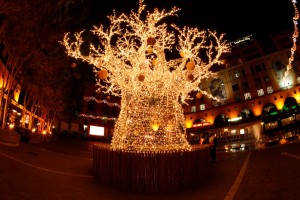After circling the globe and dropping in on friends in the four corners of the earth, it seemed fitting to end our journey with a tribute to our friends who have suffered more than their share of trauma in the past year: les Français. For those who know that I am an avowed francophile and French speaker, it may come as a surprise that I have never spent Christmas in France. I spent six years in Switzerland, just half an hour from the French border, but can't say I've had the pleasure of a purely French Christmas. That said, there are many traditions in the French-speaking part of Switzerland that are shared with the French. It seems Christmas in Paris has passed relatively uneventfully this year. Thank God. According to some of my friends, emotions are understandably a little more intense for Parisians who celebrate Christmas. And just as many Americans in the US love to be in New York City at Christmas time, many French and foreigners alike flock to Paris to see the lights and sights. From the famed Champs-Elysées:
...to the Eiffel Tower, whose second level is turned into an ice skating rink:
...to the posh department stores such as Galeries Lafayette:
...there is something for everyone.
But those outside Paris will tell you that there is much more to see in France than Paris -- and they of course are absolutely right. Because the country has many diverse regions, Christmas customs can also be just as diverse. One of my favorite cities is Strasbourg, just across the Rhine River from Germany. The city calls itself La Capitale de Noël, and it's not hard to see why. Its Christmas markets make even the grinches among us want to get out and do some browsing, stopping perhaps for a cup of vin chaud or some hot chestnuts.
France is famously secular, but there are still many who will attend a midnight Christmas mass if at no other time of year. The big Christmas Eve feast, called the réveillon, very often includes seafood such as shrimp, oysters, or lobster, and other famous French delicacies such as escargots and foie gras (goose liver paté), often alongside a roast turkey with chestnuts. Dessert, more often than not, will be a bûche de Noël (Yule log). It is generally a yellow sponge cake in the form of a roulade, iced with chocolate buttercream or ganache frosting to look like an actual log. Perhaps not the most visually appetizing, but delicious nonetheless (at least the Swiss ones are). The origin of the actual Yule log burned in many European hearths on Christmas Eve is unclear, likely dating back to pre-Christian paganism like many other modern traditions. But blogger Gerard Paul sheds some good light on the history here.
Just a few days later, there will be another réveillon, this time at New Year's, also called Saint Sylvestre. Here you will taste some of the finest cuisine, wines, and champagne, as they toast each other and the prospects of a new year.
May those prospects be the most hopeful yet for our amis français.
Joyeux Noël et Bonne Année!





![50_marche_noel_Strasbourg[1]](https://images.squarespace-cdn.com/content/v1/5a7b77f68fd4d23f09ae41b8/1518048687812-OKVHKNOX5NDCP907IW8K/50_marche_noel_Strasbourg1-300x234.jpg)























